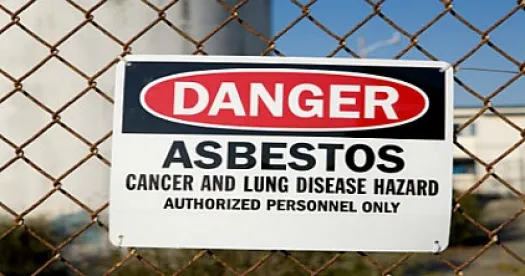On March 17, 2023, the U.S. Environmental Protection Agency (EPA) released additional data related to the proposed risk management rule for chrysotile asbestos for public comment. 88 Fed. Reg. 16389. According to EPA’s March 16, 2023, press release, these data concern chrysotile asbestos diaphragms used in the chlor-alkali industry and chrysotile asbestos-containing sheet gaskets used in chemical production. EPA states that it may use the data in the development of the final rule, including the proposed chrysotile asbestos prohibition compliance dates for these uses. EPA requests public comment on any data in the docket that were received during and after the proposed rule public comment period and about how EPA should consider it during the development of the final rule. Comments are due April 17, 2023.
In April 2022, EPA proposed to prohibit the ongoing use of the only known form of asbestos currently imported into the United States, chrysotile asbestos. According to EPA, this form of asbestos is found in products like asbestos diaphragms, sheet gaskets, brake blocks, aftermarket automotive brakes and brake linings, other vehicle friction products, and other gaskets. The proposed rule would protect people from the unreasonable risk to human health from chrysotile asbestos, which EPA evaluated in Part 1 of the Risk Evaluation for Asbestos. EPA states that it “also is working expeditiously to complete a Part 2 of the Risk Evaluation for Asbestos, evaluating legacy uses and associated disposals, including other types of asbestos fibers in addition to chrysotile.”
According to EPA, raw chrysotile asbestos currently imported into the United States is used exclusively by the chlor-alkali industry. Chlor-alkali chemicals are used in important sectors, including for the disinfection of drinking water. EPA states that “most chlor-alkali plants no longer use asbestos diaphragms, and alternatives are available,” however.
EPA originally proposed that the prohibition on the commercial use of chrysotile asbestos diaphragms would occur two years after the effective date of the final rule to give facilities time to transition away from asbestos technology. EPA requested comment on whether this timeframe was practicable, including information on the specific and detailed timelines to build or convert existing chlor-alkali facilities to asbestos-free technology. EPA states that it “received significant comment on these issues during the proposed rule comment period.”
According to EPA, after the comment period, it received comments and met with stakeholders, including affected industry and other interested groups, about the use of chrysotile asbestos diaphragms in the chlor-alkali industry and chrysotile asbestos-containing sheet gaskets used in chemical production. EPA states that many commenters argued that the two-year timeline would not provide the chlor-alkali industry a reasonable transition period and requested additional time to allow the chlor-alkali industry to transition away from asbestos-containing diaphragms, to allow for this transition to occur without causing economic disruptions, and to avoid public health impacts resulting from potential disruption of drinking water disinfection supplies due to fluctuations in the production of chlorine.
EPA states that it also received comments supporting the two-year prohibition timeline, including a letter from the Asbestos Disease Awareness Organization (ADAO) that stated: “EPA’s proposal correctly calls for the chlor-alkali industry to stop importing and using asbestos two years after the final rule becomes effective … this phase-out deadline … can be accomplished without disrupting the U.S. supply of chlorine and caustic soda … [industry’s] recent voluntary closure of substantial asbestos-diaphragm capacity demonstrates that the remaining plants can be shut down quickly and without hardship to industry or consumers.” According to EPA, another letter from ADAO provides information to show that the chlor-alkali industry “has shut down a substantial portion of its asbestos diaphragm production capacity in the last three years and is in the process of transitioning to non-asbestos membrane technology,” and information on industry conversion to membrane technology, specifically the conversion of the OxyChem facility in LaPorte/Battleground, Texas.
In the Federal Register notice, EPA states that it is seeking comments on how to consider the additional information received regarding maintaining the prohibition compliance dates, staggering the prohibition compliance dates, or establishing longer deadlines for the prohibition on processing, distribution in commerce, and commercial use of chrysotile asbestos for chrysotile asbestos diaphragms for use in the chlor-alkali industry and chrysotile asbestos-containing sheet gaskets used in chemical production. EPA also seeks comments on the new information provided regarding the practicability of measuring 0.005 fibers per cubic centimeter (f/cc) and 0.0025 f/cc for an eight-hour work shift by existing sampling and analytical protocols and how EPA could put in place effective interim exposure reduction requirements in a way that they are compatible with Occupational Safety and Health Administration (OSHA) requirements and industrial hygiene practices, where those requirements and practices will address unreasonable risk until prohibitions are fully implemented. EPA also seeks comments on the workplace safety concerns in the chlor-alkali industry raised by ADAO in its comments. Comments are due April 17, 2023, and can be submitted to Docket EPA-HQ-OPPT-2021-0057. More information on EPA’s proposed risk management rule is available in our April 7, 2022, memorandum.
Commentary
For asbestos stakeholders, this is an important opportunity to comment. It is clear that EPA is struggling to reconcile conflicting data and information, and the resolution of these differences will have a significant impact on the final risk mitigation rule. Another confounding issue is the short 30-day comment period. Stakeholders will need to work quickly or seek more time, which EPA may be reluctant to give.



 />i
/>i


